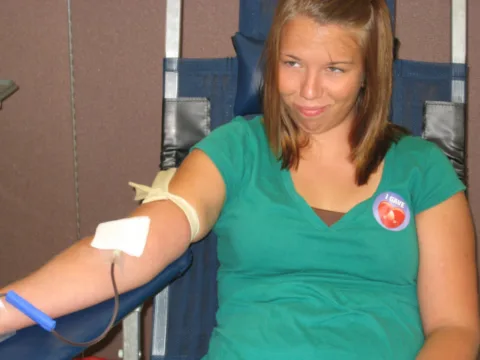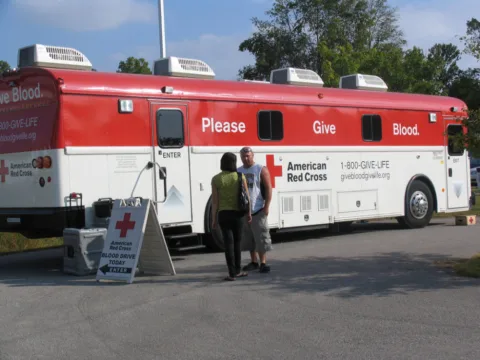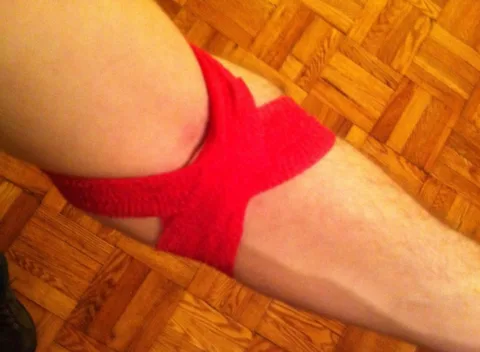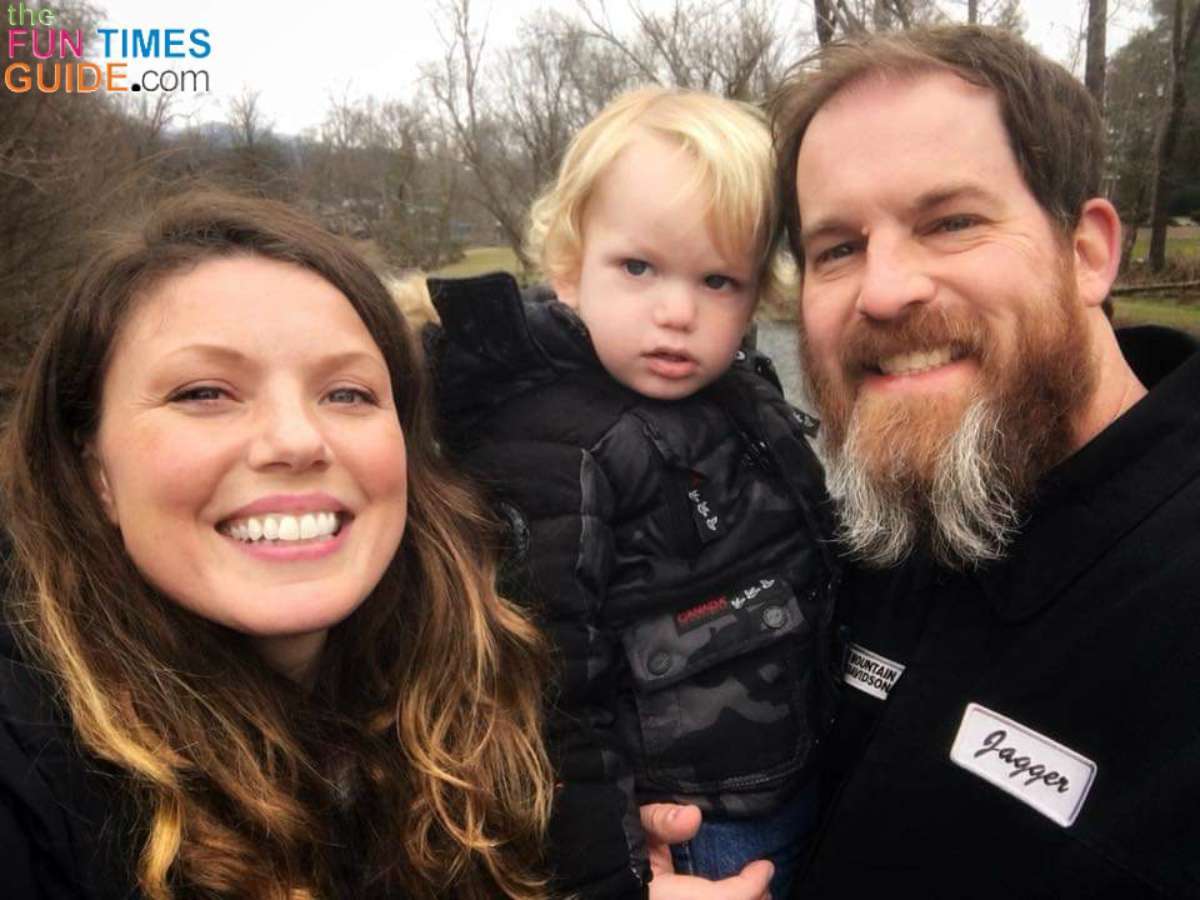I finally decided to donate blood for the first time.
It was a relatively impromptu decision, really. My girlfriend and I saw the Bloodmobile parked outside church, and we decided to stop in after Mass to donate blood.
Find a Bloodmobile near you.
She’s a pro at this, having given blood umpteen times over the years. I, on the other hand, managed to go 35 years with relatively little blood loss (thank goodness) and had yet to donate blood.
She encouraged me to roll up the proverbial sleeve — explaining that the process of giving blood really isn’t that bad, that it’s pretty quick and easy to donate blood, and doing so can help save lives. (She’s a certified nursing assistant, by the way.
Why Donate Blood… Don’t They Manufacture It Nowadays?
Every time there’s a major crisis, it seems you’ll hear newscasters, local emergency teams, and others say one of the best things you can do to help is to give blood.
In just about every city, there’s generally a greater demand for blood than there is a safe supply of it.
According to the American Red Cross, about 38% of the general population (or about 2 out of every 5 people) is eligible to give blood. Yet less than 10% of that figure actually do donate blood (only about 1 in 25 people).
All blood types are welcome and needed, but those who have O negative blood (sometimes known as the universal blood type) are in highest demand — especially in times of emergencies.
A person can give whole blood donations as many as 6 times per year. So if you’re healthy and feel like being generous, you can definitely help stock the local blood supply on a fairly frequent basis.
But why should you give blood if it can be made?
Here’s some news: at this time, blood cannot be synthetically manufactured — though scientists are working on this.
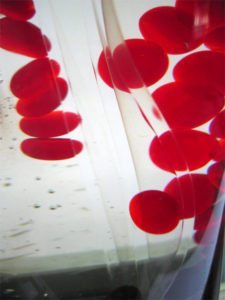 Remember, blood isn’t just a red fluid in your body — it’s composed of cells, including:
Remember, blood isn’t just a red fluid in your body — it’s composed of cells, including:
- Red blood cells that carry oxygen.
- White blood cells, which help fight infections.
- Platelets that help clot to stop bleeding from cuts and scrapes.
- A yellowish liquid called plasma that delivers proteins, nutrients, and hormones throughout your body.
You see, blood is a very complex bodily fluid that doesn’t just help you live but is essentially life itself. While scientists are working on ways to manufacture blood, we aren’t to a point yet where we can simply make blood in a lab.
Even should the day come that scientists can make blood on a large scale, it will probably always be preferred (and most likely cheaper for medical facilities) to use real human blood from donors than to utilize a synthetic, or lab-made source.
The bottom line? Give blood if you can. Each blood donation could save as many as 3 lives. Pretty cool, huh?
What It’s Like Donating Blood For The First Time
My first time donating blood wasn’t an in-and-out experience.
The first 20 minutes I spent chatting with a nurse and discussing some of my medical history. I also had to answer prompts in an online questionnaire.
The questions were varied and included:
- Have you had a flu in the past 2 weeks? I actually did…
- Have you taken any aspirin in the last 48 hours? Nope…
- Have you had an accidental needle-stick in the past 12 months? I wondered if accidentally poking myself by a sewing needle counts — didn’t really break much skin. The answer? Nope, I’m clear…
- Have you had a blood transfusion in the past 12 months? Nada…
- Have you spent time totaling 3 months or more in the United Kingdom between 1980 and 1996? I had no idea why this even mattered, but I never went outside the U.S. during that time — Negatory…
Here’s why they ask the question about living in the U.K. between 1980 and 1996.
After answering several dozen questions like the ones above, I was cleared for the next step of the blood donation process: getting my vitals taken.
I was directed to an enclosed room at the back of the bus where my blood pressure was taken, a pulse oximeter was strapped to my index finger to check my oxygen levels, and a thermometer was popped into my mouth.
Even though I had a flu during the previous week, my temperature was normal, and my other vitals checked out well, too.
Time to donate blood!
Roll Up Your Sleeve: It’s Time To Donate Blood
After my vitals were checked, I was kindly instructed to sit down on 1 of the 4 patient beds located in 2 pairs along either side of the main walkway in the Bloodmobile.
I chose a bed adjacent to my girlfriend, who had just finished getting cleared for her blood donation.
Moments after reclining into the bed, I started to feel lightheaded. It may have been nerves, or perhaps it was due to the fact that I had fasted the entire morning before Mass. It was now 2 PM — and I was famished!
I asked the nurse if I could have a small bottle of orange juice and cookies to help raise my blood sugar and keep me from feeling hungry while I was in the chair. She kindly obliged, and off I went drinking my orange juice and eating cookies.
For a moment, indulging on OJ and cookies, I felt like I was back in kindergarten enjoying a snack after nap time! Actually, when I was a kid, I found out on an episode of Bill Nye: The Science Guy that drinking juice and eating cookies reduces the chance of shock and can help replenish blood cells that you lose when you donate blood.
Here’s the episode:
Anyway, I hadn’t knocked off more than 1 or 2 cookies before the nurse asked me to begin squeezing a ball in my left hand to help enlarge my blood vessels in that arm. This pumping action helped to enlarge my veins and make it much easier for the nurse to find a sufficient vein for donating blood.
With a few squeezes of the ball, the veins in my left arm looked ready for tapping. Apparently, the nurse thought the same thing — because she promptly began swabbing an antiseptic on my left arm to clean the site prior to injecting a needle.
I was asked to continue pumping the ball even while she was cleaning the site to keep the vein enlarged.
As the antiseptic dried, here’s what happened:
- The nurse grabbed a needle, catheter line, and bag.
- She hooked the bag to a device at the base of the bed I was laying on, and then she tied the line to another point higher up on the bed near my left shoulder.
- Next came the needle, which the nurse slowly but surely slid into my arm. I felt a slight burning sensation at the site of the injection — but no intense pain.
“Keep squeezing the ball!” the nurse politely exclaimed as the line sat in my arm. A trickle of my blood hit the inside of the bag every time I squeezed the ball.
I began feeling nauseated about 5 minutes into donating blood for the first time. This was probably due to the pressure I felt at the injection site with each pump of the ball in my left hand. The nurse told me that squeezing the ball would help quicken the process of filling up the ol’ blood bag.
Of course, there was probably some psychological factor behind the nausea. But I was also very hungry before I decided to donate blood, and I normally become lightheaded if I go too long without eating.
Meanwhile, I simply focused on squeezing that ball and trying to distract myself from the nausea.
TIP: To help you feel more relaxed, I recommend reading, talking to the nurse and other people who are donating blood, or closing your eyes and resting while you’re donating blood.
I was mildly amused at how the bed felt like it was rocking a bit every few moments. It turns out that the device the blood bag was strapped to was doing the rocking — that’s how they help keep the blood fresh and liquidy before it goes into the refrigerator!
I kept squeezing that ball, breathing quietly, and closing my eyes — whatever it took to distract me from the nausea, which eventually went away.
My girlfriend, who was reclined 4 feet away on the adjacent bed, cracked jokes about blood draws — which was entertaining to say the least. And the laughter helped carry the last 15 minutes that I spent squeezing my way to a full pint of donated blood.
The nurse saw that I had made it to the blood donating finish line, so to speak, and proceeded to unhook the catheter line from the bag and place it wherever it needed to go in the Bloodmobile for further processing.
She then removed the needle and immediately pressed a cotton swab over the injection site — much like phlebotomists do when I’m getting my blood work done during my annual physicals at the doctor’s office.
She wrapped bandage tape around my arm and over the cotton and then said I was ready to go. My girlfriend, as it worked out, had just finished up donating blood by the time I sat up from the bed.
We were each handed our blood donor T-shirts by our nurses and headed out the door of the Bloodmobile.
The entire process, from start to finish, took about 50 minutes. All in all, it was really simple to donate blood and it’s awesome knowing I may have just helped save 3 lives!
I’ll definitely be donating blood again someday.
What To Do After You Donate Blood
So, you’ve successfully made it through your first blood donation process, what should you do next?
Here are some tips:
- Drink 4 to 6 cups of water within 24 hours after you’ve donated blood — to help replenish your blood and to avoid dehydration.
- Eat iron-rich foods — to help restore your blood supply.
- Remove the bandage wrap from your arm about an hour after the procedure — but leave a smaller strip bandage over the injection site for several hours afterward.
- Avoid lifting anything heavy for the rest of the day — especially if you were lightheaded or queasy while donating blood.
- If the needle site begins bleeding, apply pressure to that area of your arm and keep your arm elevated for 5 to 10 minutes — which should stop the bleeding.
- If you start to feel dizzy or lightheaded afterwards, stop the activity you’re doing and sit down. For the next 24 hours, abstain from any activities that may cause dangerous fainting risks.
- As always, if you feel you are experiencing a serious medical emergency, call 911.
My Best Tips Before You Donate Blood
Had I known I was going to donate blood, I would’ve done a better job at eating that morning to avoid being lightheaded or nauseated during the procedure.
In my Catholic religion, the ritual is to fast for only 1 hour before receiving Communion. I regularly go an hour or two without eating each day anyway, so there’s certainly nothing inherently problematic for blood donors to give blood right after Mass or any other time when they haven’t eaten for a couple hours.
TIP: So long as you eat something healthy after giving blood, you shouldn’t have any issues — even if you didn’t eat right beforehand.
I’d personally just suggest if you’re prone to getting lightheaded when you’re hungry or are diabetic (currently, diabetics who control their blood sugar numbers well are eligible to donate blood in the United States), just make to eat a proper meal before donating blood.
The best things to eat just before donating blood are foods high in iron and foods low in fat.
Avoid fatty foods, such as hamburgers, fries or ice cream before donating. (Fatty foods can affect the tests we do on your blood. If there is too much fat in your blood, your donation cannot be tested for infectious diseases and the blood will not be used for transfusion.) Source
If your blood can’t be properly tested, it can’t be used for a transfusion. So, be sure to:
- Drink at least 16 ounces of water (or a non-alcoholic beverage) before donating blood.
- Wear a loose-fitting shirt with sleeves you can easily roll up.
- Bring your ID!
More Info About Donating Blood
In addition to the links I’ve included above, here are some helpful resources for the first time you donate blood:

